(ISSN: 2831-7416) Open Access

To sleep tight you should sleep right.
Noronha T*
Physiotherapist, Primary care at ACES Oeste Norte, ARSLVT Portugal
*Correspondingauthor: Noronha T, Physiotherapist, Primary care at ACES Oeste Norte, ARSLVT Portugal
Receiveddate: 24 Oct, 2022 |
Accepteddate: 12 Nov, 2022 |
Publisheddate: 17 Nov, 2022
Citation:Noronha T (2022) Tosleep tight you should sleep right. J Case Rep Med Hist 2(7): doihttps://doi.org/10.54289/JCRMH2200134
Copyright:© 2022 Noronha T. This is an open access article distributed under the terms of the Creative Commons Attribution License, which permits unrestricted use, distribution, and reproduction in any medium, provided the original author and source are credited.
Abstract
The impact of environmental context and lifestyle to our health is crucial. Balancing physical activity and rest, especially sleep, is the key to healthier ageing and greater functional capacity.
Humans spend about 1/3 of their lives sleeping, usually in the recumbent position.
Favourable sleeping environment is not only a quiet place but also an adjustable sleep system may hold one of the keys to sleep right and tight.
All systems deteriorate with ageing, and the vascular system is particularly affected, which in turn aggravates the natural limitations that occur in the musculoskeletal system. In this paper we will see why sleeping system should be addressed to meet the increased impairment of the musculoskeletal system and the sleep function.
The age related decrease in vascular function affects all body systems, and also exposes the musculoskeletal system to greater risk factors for chronic pain conditions.
Changes occurs also in sleep architecture, the decreasing shifting of positions while asleep, the adoption of side lying and less posture options due to health conditions alone are some of the risk factors for sustained compression on all the musculoskeletal structures, particularly in the side of the body in contact with the bed. Shoulders and hips are the regions of the body that suffer greater pressure and impaired blood perfusion.
Musculoskeletal conditions and sleep disorders in the United States alone affect about 50%of the 126.6 million American adults; about 40% of those subjects who suffer from low back/neck pain, sustain pain and sleep disturbances despite analgesic treatment. Women are more susceptible to these complaints, especially those with more prominent body contours, or frail people with severe muscle atrophy.
Ageing increases the demand for a better contextual environment, not only during activity but also at rest and especially during sleep.
This paper based on the records of a case series study of 19 subjects focusing only on paraesthesia and comorbid insomnia and their evolution with the systematic application of a customised topper.
Keywords: Chronic Musculoskeletal Condition; Sleep Disturbance; Contextual Approach; Postural Adjustment; Physiotherapy Management
Abbreviations: VAS: Visual Analog Scale
www.acquirepublications.org/JCRMH
Journal of Case Reports and Medical History
Case Report Volume 2 Issue 7
Background
As a physiotherapy consultant in a public health centre with over 60,000 users, my mission is to promote health by supporting everyone who comes to me for help to solve their health conditions or to find a way to reduce their burden.
In 2017, the family physicians of my health centre referred to my service 169 patients with chronic complaints of various health conditions with no positive response to pharmacological treatment, of which 138 subjects with musculoskeletal condition complaints and impairment in multiple activities of daily living. More than 50% of the patients had multiple health conditions, presenting various limitations of daily living and multiple
pain sites, in a pattern similar of which is found in the literature [1,2]. Many of these patients’ complaints of sleep disturbance and impaired walking, others have difficulty in accomplishing tasks of their job, a finding that is also referred by [3 7]

Despite a vast amount of epidemiological data on pain and sleep disturbance, the scientific community is still trying to understand the mechanism of both chronic pain and insomnia [8 13]
Since 2015, at the first contact with the patients, I have been using this image to identify the affected sites referred by the patients this practice is echoed by other researchers, such as [14 17]
The physiotherapy assessment also included: a) Patient Specific Functional Scale Assessment; b) Visual Analog Scale (VAS) for Pain and Paraesthesia; c) Postural Assessment in activity and at rest. When appropriate, the intervention was directed at:
• Patient empowerment in the management of pain
• Home exercise program
• Postural adjustment in side lying with the application of customized topper.
All these procedures were applied during 3 direct contacts (T1; T2:T3) and was completed with electronic contact in a 12 months period.
The initial assessment (T1):
To determine the functional limitation of Sleeping and other daily activities, was applied the Patient Specific Functional Scale, ranging from 0 = unable and 10 = able as before complaints.
The pain with neuropathic characteristic was assessed by “VAS”, the Visual Analog Scale, ranging from 0 = no pain/paraesthesia; 10 = worst pain/paraesthesia ever. Besides the assessment of pain and functional limitations, most patients were advised to avoid aggravating factors and to adopt modified gestures for their daily or occupational activities.Otherswereadvisedtogetsomesupportequipment in conjunction with the therapeutic exercise prescription. Before being able to apply the topper, the patients were first instructed to place a long fluffy pillow under the chest and up to the waist in order to create an open space for the arm to reduce some compression, and folded towels were placed under the head pillow to match the height created by the pillow placed under the chest.
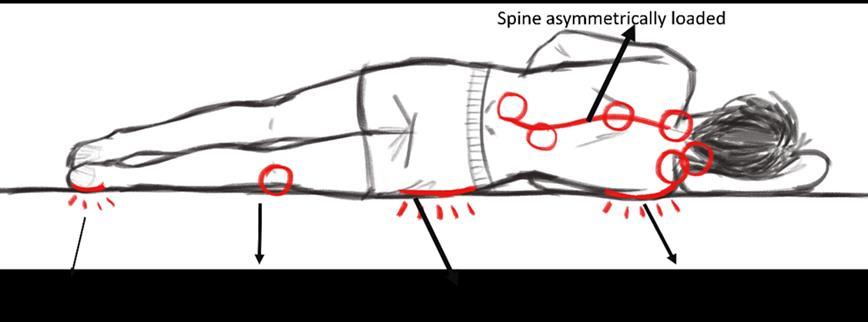
Postural assessment in the preferential sleep position on subject’s sleep system was done via image sent by email.
Patients were advised to ask someone to take their front and back images from head to toe while stay lying on their own
Journal of Case Reports
Medical History www.acquirepublications.org/JCRMH 2 2
and
bed and pillow at a horizontal plane in order to get the exact angle to measure any misalignment of the spine.

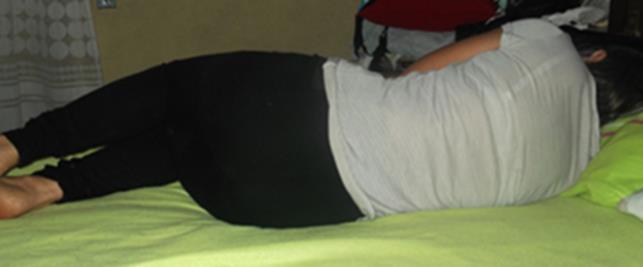
Second direct contact (T2): This contact was scheduled after receiving recumbent posture images taken from the subject's sleep system to analyse the
posture with the subject and to adjust more accurately and to teach how to makeone's own topperaccording to thepersonal conditions.
The preferred sleeping position most adopted was side lying, which is in accordance with the findings of [18 22]
To customise the topper, it is essential to determine the points that are directly in contact with the mattress by obtaining the anthropometric parameters and evaluating the lying posture in one's usual sleeping system [23-26]
The following measures were taken:
1. The widest part of the body that is pressed onto the mattress is the deltoid region or the hip, in accordance with the contour of the body. The width measured from the most lateral surface of the right to left deltoid muscles.
2. The circumferences of the Chest, the waist and the hip.

3. The length from C7 to L5; L2 to the Iliac crest and Great Trochanter to malleolus.

There were some contacts between these direct contacts to ensure the timely monitoring and rectify some inaccurate topper application.
In 2017, the contextual approach was systematised to reduce one of the factors of pain complaint and sleep disturbance through the introduction of a customized topper.
*The angle is measured with the Angulus software with the image of the conceptual model.
Case
www.acquirepublications.org/JCRMH 3 3
Journal of
Reports and Medical History
Third direct contact (T3): Scheduled todischarge usually6 to12months afterachieving maximum functionality relating to the patient's health
conditions. The criteria to discharge were the highest functional level and the reduction of pain/paraesthesia.
*The angle is measured with the Angulus software with the photo sent by the subject.

The sample consists of 8 men and 11 women ranging in age between 29 and 78 with a mean of 55,7 years old, all of whom
presented complaints of increased paraesthesia and comorbid insomnia
It was hypothesised that most of the paraesthesia shown in the graph may come from misalignment of the cervical spine, and thus, the rationale for the intervention was directed to the recumbent posture adjustments.
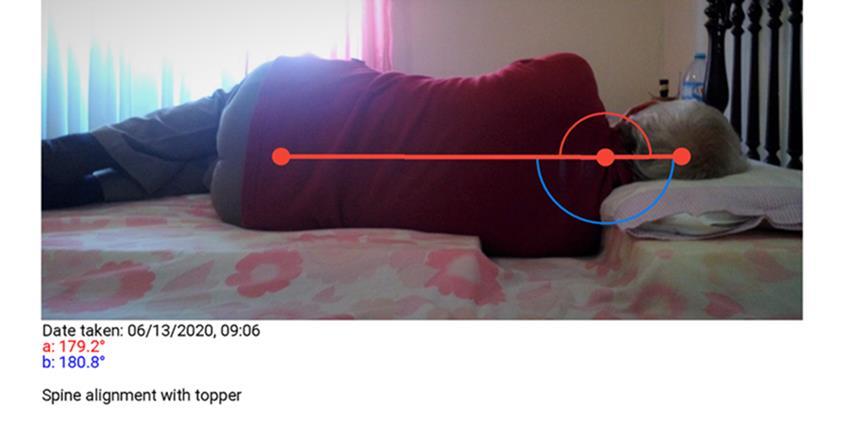
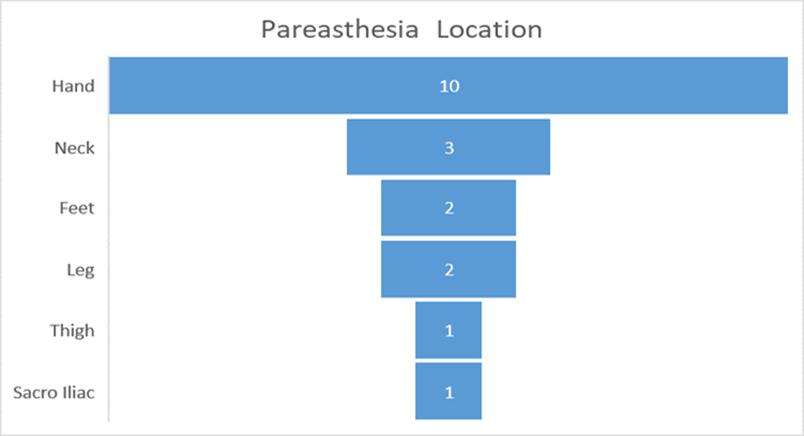
www.acquirepublications.org/JCRMH 4 4
Journal of Case Reports and Medical History
Journal of Case Reports and Medical History
The table below presents the data collected from the subjects with exacerbation of paraesthesia in recumbent posture and the outcome following application of the customised topper.
N ClinicalInformation Age/ Gen der

Disabling Activities Patient
EspecificFutionalScale 0 = Unable; 10 = Able as normal
T 1 T 2 T 3
Location of Paresthesia VisualanalogScale 0=NoParesthesia; 10=WorstParesthesia
P 1 P2 P3
1 Low Back, Neck pain; Hand numbness 53/F Main Sleeping 4 8 10 Right Hand 4 1 0 2nd Dressing 5 7 10 3rd Weight lifting 5 5 10
2 Hand pain, polyarthralgia 66/M Main Walking 4 10 10 Right Hand 5 2 1 2nd Sleeping 5 5 10
3 Lumbosciatic pain 64/M Main Walking 5 8 10 Left Thigh; 5 1 0 2nd Sleeping 5 9 10 Right Thigh 2 0 0 3rd Weight lifting 2 8 10 Sacro iliac 4 1 0
4 Disks herniation 42/M Main Sleeping 5 8 10 Hands 7 4 0 2nd Job Activity Feet 5 2 0
5 Back pain 44/F Main Sleeping 5 6 9 Right Hand 6 4 0
6 Right Shoulder pain, hand numbness 52/F Main Sleeping 6 8 10 Right Hand 4 0 0
7 Post op 2016 L5_S1 33/M Main Walking 5 8 10 Left Leg 6 2 0
8 Neck Pain; hand numbness 50/F Main Sleeping 3 7 10 Right Hand 6 3 0 2nd Ironing 5 8 10 3rd Cleaning 4 4 4
9 Post op 2016 78/F Main Walking 5 7 9 2nd Sleeping 3 7 9 Hands 6 3 0 3rd Bathing 5 7 10
10 L4 5 herniation 48/M Main Walking 4 9 Thigh 4 0 2nd Get up from bed 3 9 3rd Driving 3 9
11 Neck pain; hands numbness 76/M Main Sleeping 3 10 10 Hands 7 0 0 2nd Getting up/sitting on chair 6 9 10
12 Post op C4 63/M Main Sleeping 3 9 10 Neck 7 1 0 2nd Getting up/ sitting on chair 4 5 8
13 Post op L5 S1 29/F Main Walking 4 7 9 Thigh 5 2 1 2nd Sleeping 3 8 9 Leg 5 2 1 3rd Sitting 4 8 10
14 Herniate disc D7 8 48/F Main Sleeping 3 8 9 Neck 8 2 0 2nd Job Activity 5 8 10
15 Degeneration discs C5 6 7 56/F Main Sleeping 3 8 10 Neck 8 1 0 2nd Job Activity 2 8 10 Right Hand 8 3 1
16 Sciatic pain L4 5 63/F Main Walking 5 6 9 Feet 4 4 0 2nd Sleeping 4 4 9 3rd Sitting 4 5 9
17 Listhesis c3 4 and C4 5 59/F Main Job Activity 4 9 10 Head 7 1 0 2nd Sleeping 4 9 10 Hands 6 2 0
18 lumbosciatic pain 73/M Main Walking 4 6 10 Feet 6 3 1 2nd To Dress 2 3 9 3rd Sleeping 5 5 9
19 Listhesis C5; Herniate disk L1 L2; L2 L3; L3 L4
61/F Main Walking 2 6 9 Feet 8 5 4 2nd Sleeping 2 8 10 Hands 5 2 0 3rd Sitting 1 7 9
T1 First assessment Ability to “Stay Asleep” T2 Assessment Timeframe of approximately 7 to 10 days after the image of side lying taken from the subject's sleep system “Stay Asleep”. T3 Last Assessment Timeframe of approximately 6 to 12 months after the application of the topper Ability to “Stay Asleep”
P1 Level of paraesthesia at first contact; P2 Level of paraesthesia following topper application; P3 Level of paraesthesia at the last direct contact
www.acquirepublications.org/JCRMH 5 5
To better illustrate this intervention, I will describe and analyse two clinical cases.
For instance, to the case number 8, a patient with an onset of 2 months and no relief from pharmacological treatment. One usual evolution of this condition, that is not responding to traditional pharmacological therapy, should be a case chronification with a tendency of widespread complaints. Case 8 was referred by the GP on 12 april 2017.
Clinical information:
Right shoulder pain with numbness and decreased strength in the right upper limb.
Onset of pain and paraesthesia within 2 months and progressive aggravation despite the use of anti inflammatory therapy.
The cervical X ray and EMG of the upper limb were normal.
First contact (T1) on 5 may 2017
Observation:
Asymmetrical posture with inclination of the face to the right. Protraction of the head; increased physiological spinal curvature.
Exacerbation of shoulder pain and paraesthesia is occurring at night while sleeping, preferential sleep posture being on the right side which, due to pain, the patient tries to sleep on the left side.
T1 5 may 2017 Functional evaluation: Main Complaint Functional limitation in sleeping (severe sleep disturbance) and in daily activities due to paraesthesia of right hand and pain in both shoulders, more severe on left side.
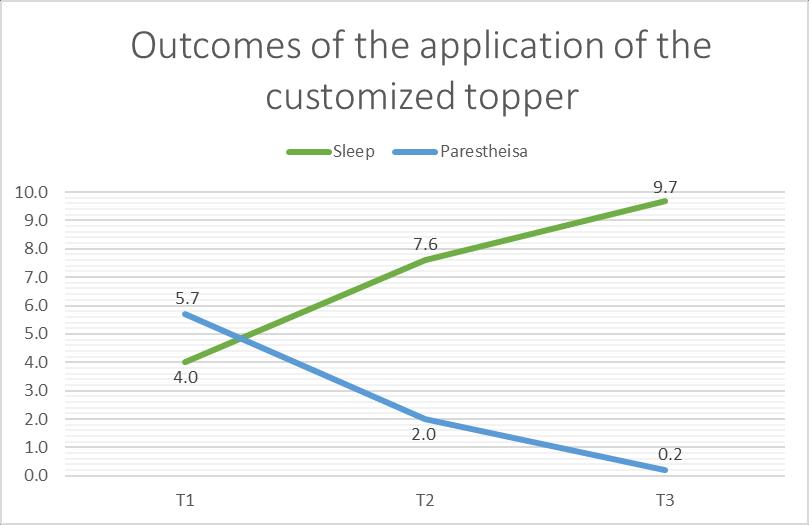
Exhaustion and decreased strength for ironing and cleaning windows.

Constant pain, level 4, increasing to level 6 with upper limb movements of flexion, abduction, adduction and internal rotation.
Mild paraesthesia of the right hand and lack of strength.
Exacerbation of shoulder pain escalating to level 8 and awake with hand paraesthesia while asleep.
The table below synthesizes the findings.
Journal of Case Reports and Medical History www.acquirepublications.org/JCRMH 6 6
Journal of Case Reports and Medical History

(ISSN: 2831-7416) Open Access
Lists of impaired activities
PatientCentredFunctionalAssessment
T1 T2 T3 5 5 17 24 5 17 6 8 17
Main complaint Staying asleep 3 7 10
Cause Right shoulder pain and hand paraesthesia
2nd Complaint Ironing 5 8 10
Cause Right shoulder pain
3rd Complaint Cleaning 0 Did not try 10
Cause Right shoulder limitation of movement and pain
Functional Scale 0 to 10 (0 = unable; 10 = completely able)
T2 Observation 24 May 2017
The patient reported a significant improvement both in her ability to stay asleep as well as a decrease in paraesthesia. The custom topper application was well applied but not fully adjusted.
The height increase induced by the topper is also levelled out at the pillow height by applying the same number of layers of denser sponges placed under the pillow.
The image shows a slight deviation of the cervical spine due to the lack of adjustment of the pillow, which may be the source of complaints. Therefore, the need to evaluate it directly.
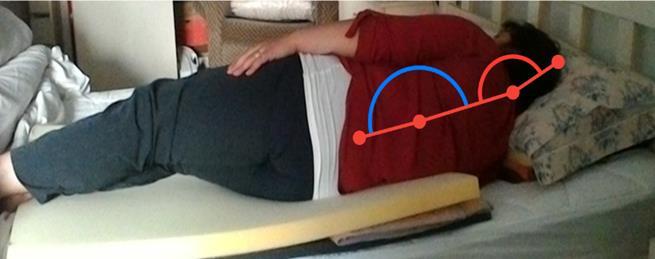
The pillow was too high causing a slight cervical misalignment. In order to refine and remove any malalignment, she was advised to bring the pillow to evaluate the need to replace or adjust it.
Maintain specific exercises to improve functional capacity.
a)164.1º; b)178,0º Pillow too high.
T3- Observation 6-August-2017:
The patient had changed her pillow for one with hollow cotton fibre filling placed in a cotton pillowcase with elastane fabric with a zipper to make it easier to manage its height. She was discharged fully functional with no pain nor paraesthesia
She described a relapse episode due to a weekend trip to another city, and immediately experienced the same symptoms as before the application of the customize topper.
She has alreadyperceived thecause of hercomplaints and has beentaughttheneedfuladjustment,ifnotsucceedcouldreach me by email.
Case 11 76 years old retired male.
Clinical information:
Bilateral gonarthrosis and heart disease.
Overall health conditions Cardiac condition, Sequelae of direct trauma of the knees, sleep apnea.
Onset of Paraesthesia of right hand at night for over 6 months.
www.acquirepublications.org/JCRMH
Journal of Case Reports and Medical History

T1 23 jun 2017
Observation:
The patient has understood the strategy and sent the images the next day. He got the prescription of the topper by email, but the patient was unable to come before September.
After applying the customize topper he sent the images of his preferred lying posture on the topper.
Symmetrical posture with slight trunk flexion but without impairing normal gait.
He was advised to use a roll of hollow fibre with 40cm x 120cm, to place between the lower limbs to prevent knees compression on side lying and lessen the load of the hemi body was in contact with the mattress.
The table below synthesizes the findings PatientCentredFunctionalAssessment
Lists of impaired activities T1 T2 T3 23 6 17 28 9 17 27 11 17
Main complaint Staying asleep Sleep Paraesthesia Sleep Paraesthesia Sleep Paraesthesia Cause Severe right hand paraesthesia 3 9 10 0 10 0 2nd Complaint Get up from a chair/bed Get up from a chair/bed Pain Get up from a chair/bed Pain Get up from a chair/bed
Pain
Cause Knees and bilateral iliac sacrum region 5 2 9 0 10 0
Functional Scale 0 to 10; (0 = unable; 10 = completely able)
During October, the patient had travelled every weekend to assist a relative in another town. He has reported that he
experienced paraesthesia of the right hand every time he was away from home and not been able to use his topper (“t off”).
October 4Weekends Sleep Paraesthesia
t off1 Out of Topper 3 8 t on1 With Topper 10 0 t off2 Out of Topper 3 8 t on2 With Topper 10 0 t off3 Out of Topper 3 8 t on3 With Topper 10 0 t off4 Out of Topper 3 8 t on4 With Topper 10 0
The table below presents the effect of an adjusted sleep system. This case reinforces my view that customised topper improved the contextual conditions by removing the biomechanical stress mechanism that the musculoskeletal system was being exposed to, thus reducing comorbid insomnia due to pain or paraesthesia.
Discussion
All subjects in this sample have severe musculoskeletal complaints, with worsening neuropathic symptoms related to lying position and awakening several times during the night and no relief with pharmacological treatment. This
presentation of symptoms has been already identified by several authors [27 29].
As a primary care physiotherapist my mission is to promote functional capacity and increase health literacy, as proposed by [30]
www.acquirepublications.org/JCRMH 8 8
One of the skills of the physiotherapist is the postural assessment, the current practice the evaluation at work or
In the literature, the sleep system is commonly considered constituted by mattress and its support structure [23,31]

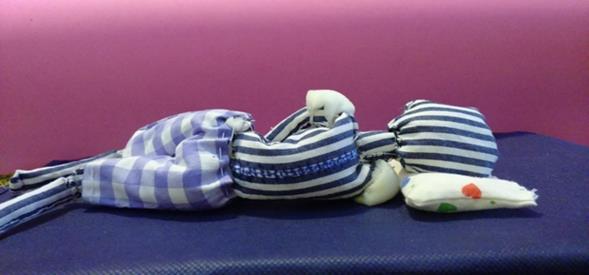
From my point of view, it should consist of all the elements indirectcontactwiththebodyintherecumbentposition,such as pillow, mattress and toppers. All the bedding should also be included, because if the chosen fabrics are too slippery, like satin, it would interfere with the muscle relaxation during sleep.
The pillow is also a very important element of the sleeping system [32 36]. But adjusting solely the pillow may partially resolve the complaints [37], and may prevent worsening, but does not reduce paraesthesia and pain [38-40]
Therefore, as some authors [41,42], propose to ensure the necessary adjustment to prevent any deviation of the spine, the postural assessment of a person lying in their preferred
sport activity, but the assessment in lying posture in clinical practice is not so common.
position in their usual context is the key to manage this pain/paraesthesia with nocturnal exacerbation [43]
Nevertheless, in my practice, to assess the lying postureof the patients on their own sleep system was a big challenge [11] Most of my patients are elderly with low literacy and only a few know how to use smartphone and send emails. It’s essential to adequately convince them to get their images taken lying in their own bed.
For the side lying, the spine should be like a straight line [17,18,23,31]. To trace any deviation of the body in relation to the sleep system together with the instruction to the photographer to take the image sitting in front of the bed, an image is sent as an example in order to obtain a view that allows correct analysis.
Despite of all the details given most of the images are not suitable for postural assessment in recumbent position, as shown in the picture below.
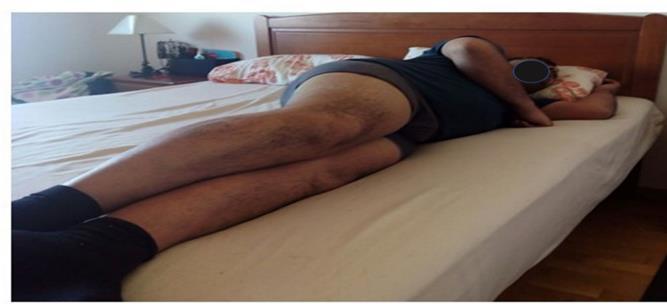
Almost all patients have financial difficulties and lack of support from family and friends. To convince them to apply a customise topper, first I suggest
This picture only perceives subject’s knees
them to use anything they have at home like duvets, pillows and towels to form the shoulder breach to decompress the affected area.
www.acquirepublications.org/JCRMH 9 9
Journal of Case Reports and Medical History
In clinical context is impossible to demand too much accuracy, and the lack of resources from the health centre and the patients requires a flexible and creative solutions in order
toreduceanyfinancialburdenandgetthebestoutcome,using any materials available at home.
When analysing the Case number 8, presented above, we can recognise that it is a recent case of musculoskeletal condition with no tangible cause and no response to analgesic or anti inflammatory treatment.
In T1, a pain assessment was made that includes the strategy to be adopted by the patient to reduce it. This patient reported that throughout the day with the activity developed at work relieved her pain, a situation identified by several authors [18,44]
At the beginning of the complaint [45], she avoided lying on the right side, but as soon as she enters “nREM”, her body moves towards the preferred sleeping position, later awakening with paraesthesia and pain, as it is referred to occur by some authors [18,46].
But after a month, she couldn't even lie on her left side because she started to feel the shoulder pain on that side, a finding that is also described in the literature as a natural evolution of the condition when not treated [47,48,49]. Gradually, she began to feel functional limitation at work. To make the patient understand and adhere to the intervention, she was explained the possible cause of her Paraesthesia/pain.
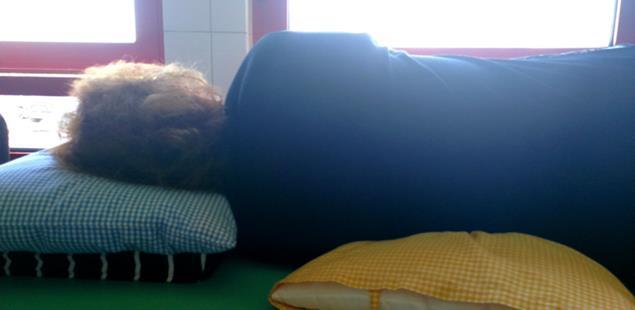
The intervention addressed thecontextual factors and she was instructed to use a pillow placed under the trunk at the level of the 10th rib and another under the head to create the shoulder breach, for her to realize the way to reduce the pressure on the painful shoulder.
She was urged to send me the images of her lying posture to enable the assessment of lying posture in her usual context to prescribe the customized topper.
After applying this topper and changing her pillow all complaints disappeared an outcome already reported by [50]
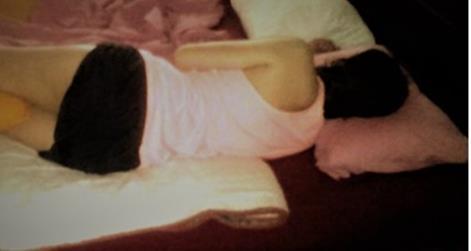
There was only one relapse due to a two nights trip out of town without the sleeping equipment, which made the pain and neuropathic signs reappear.

The outcome of the management for case number 8 was very satisfactory both at the health condition and patient literacy. Without removing that risk factor, the evolution of should be a natural aggravation of insomnia and multiplication of pain sites [44,49,51 54]. In fact, the disappearance of all complaints contributed to the total improvement of her functionality.
She was also advised to pay attention to the wear and tear of the material of any constituent elements of the sleep system or her anthropometric change, as it may mean the system might need readjustment, as stated by [55 57]
I discharged this patient only when I was assured that she already mastered the strategy and got my contacts if necessary.
Returning to the Case number 11, from the first direct contact (T1) the patient understood the strategy and sent the images the next day and received the indication with the measures and thicknesses of 3 foams sheets to make the customise topper. However, the T2 (second direct
www.acquirepublications.org/JCRMH 10 10
Journal of Case Reports and Medical History
Image showing the strategy. This woman tried with a blanket, but it’s too thin to get enough height to reduce compression.
assessment) was only scheduled for almost 3 months after the adjustment of the sleep system. Nevertheless, analysing the image lying down with the topper applied that he sent, I
advised him to use a cotton roll measuring 40cm x 120cm, to reduce knee pain by avoiding compression of the knees against each other
This patient experienced paraesthesia and pain for 4 consecutive weekends from sleeping outside his bed and the complaints disappeared as soon as he went back to the adjusted sleep system.
This fact strongly suggests that, by improving the environmental context, one could expect to reduce pain and eventually correct some postural misalignment, therefore delaying the process of musculoskeletal deterioration.
What happens to a subject who has a maladjusted sleep system, exposing himself, night after night, of sustained compression, especially on the side that is in direct contact with the mattress, and, on top of that [58 60], in conjunction with the natural deterioration of soft tissues due to aging?
During my 36 years as a physiotherapist, the following is the most heard story told by a shoulder pain sufferer:
Atthebeginning,theywokeupinthemorningwithsome discomfort and stiffness on the shoulder, that would dissipate with physical activity [5,45]
Night after night the situation deteriorated to the point that they start waking up in the middle of the night with acute shoulder pain [61-63]
Functional limitation like taking off a T shirt with pain when raising their arm more than 90º or taking out a wallet of the back pocket of the trousers, etc. They started to avoid their preferred sleeping position sharp pain on their sleeping posture pressing the painful shoulder.
Sometime later, they could only sleep in supine position. As the lack of comfortable sleeping position, muscle
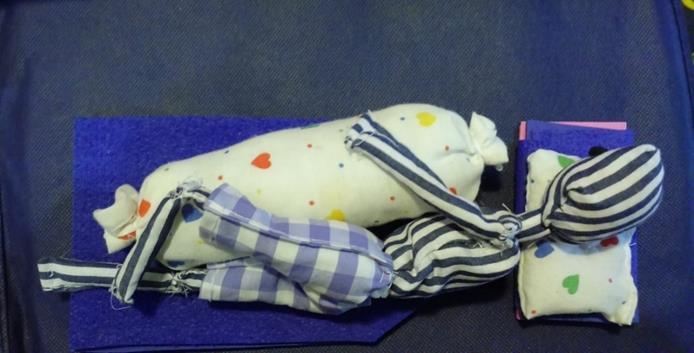
tension increased and began to feel multiplies pain sites. Neck, back and even heel pains [64 66].

Most common treatments used for these cases, [54,67 69], have not yetbeen able to meetthe needs of these sufferers and the world health system cannot stop the increasing cases year after year, as reported by [70]
Is an overview that poor posture at work can be a risk factor for musculoskeletal injuries and how about a sustained spinal misalignment night after night?
Health professionals need to think that “Man” as an element that interacts continuously with the entire environment whether active or at rest.
Conclusion
The postural assessment of the patient's usual context in recumbent position has allowed me to discover postural deviation and sustain pressure on the most prominent areas of thebodyusuallyonthe sideofthepreferredsleepingposition. The systematic application of a customised topper succeeds in reducing pain and paraesthesia, thus improving comorbid insomnia, and offers a feasible pathway of care for these health conditions.
These findings from my clinical practice could only be a clue to promote research with greater methodological rigor. The possibility of developing a topper easy to customise as a resource for the management of musculoskeletal conditions with comorbid insomnia could be the answer for millions of sufferers.
References
Case
www.acquirepublications.org/JCRMH 11 11
Journal of
Reports and Medical History
Journal of Case Reports and Medical History
1. McBeth J, et al. (2001)Risk factors for persistent chronic widespread pain: a community based study. Rheumatology. 95 101.
2. Parsons S, et al. (2007) Prevalence and comparative troublesomeness by age of musculoskeletal pain in different body locations. Farm Pract. 308 316.
3. World Health Organization. (2003) Special Theme Bone and Joint Decade 2000 2010. Burden of major musculoskeletal conditions.
4. Sivertsen B, et al. (2015) Sleep and pain sensitivity in adults. Pain. 156(8): 1433 1439.
5. Axén, Iben. (2016) Pain related Sleep Sisturbance. A Prospective Study with Repeated Measures. [autor do livro] Clin. J. Pain. Pain related Sleep Disturbance. s.l: Wolters Kluwer Health, Inc. 32(3): 254 259.

6. Bone and Joint Burden Organization. (2016) The Impact of Musculoskeletal Disorders on Americans Opportunities fo Action. Rosemont: United States Bone and Joint Initiative.
7. Uhlig BL, Sand T, Nilsen TI, et al. (2018) Insomnia and risk of chronic musculoskeletal complaints: longitudinal data from the HUNT study, Norway. BMC Musculoskelet Disord. 19(1): 128.
8. Walker, Bone K, et al. (2004) The Anatomical pattern and determinats of pain in the neck and upper limbs: an epidemiologic study. Pain. 109(1 2): 45 51.
9. Afolalu, et al. (2017) Effects of sleep changes on pain related health outcomes in the general population: A systematic review of longitudinal studies with exploratory meta analysis. Sleep Medicine Reviews. 1e16.
10. Tang,NicoleKY,etal.(2015)Impactofmusculoskeletal pain on insomnia onset: a prospective cohort study. Rheumatology. 54(2): 248 256.
11. Asih S, et al. (2014) Insomnia in a chronic musculoskeletal pain with disability population is independent of pain and depression. Spine J. 14(9): 2000 2007.
12. Andersen, Monica, et al. (2013) Sleep Sisturbance and Pain. A Tale of Two Common Problems. Spine J. 2000 2007.
13. Gran, Jan Tore. (2003) The epidemiology of chronic generalized musculoskeletal pain. Best Practice & Research Clinical Rheumatology. 17(4): 547 561.
14. Choy EH. (2015) The role of sleep in pain and fibromyalgia. Nat Rev Rheumatol. 11(9): 513 520.
15. Treede RD, et al. (2015) A classification of chronic pain for ICD 11. Pain. 156(6): 1003 1007.
16. Elavarasi, Kumar. (2016) Definition of pain and classification of pain disorders. Journal of Advanced Clinical & Research Insights. 3: 87 90.
17. Park SJ, Kim JS, Kim CB. (2009) Comfort evaluation and bed adjustment according to sleeping positions. Human Factors and Ergonomics in Manufacturing & Service Industries. 19: 145 157.
18. McCabe SJ, et al. (2011) Preferred sleep position on the side is associated with carpal tunnel syndrome. Hand. 6(2): 132 137.
19. Kempf B, Kongsted A. (2012) Association between the side of unilateral shoulder pain and preferred sleeping position: a cross sectional study of 83 Danish patients. J Manipulative Physiol Ther. 35(5): 407 412.
20. Roizenblatt M, et al. (2012) Pain related diseases and sleep disorders. Braz J Med Biol Res. 45(9): 792 798.
21. Bettlach CLR, et al. (2019) Preferences in Sleep Position Correlate With Nighttime Paresthesias in Healthy People Without Carpal Tunnel Syndrome. 2, NY: Hand. 14(2): 163 171.
22. Skarpsno ES, Mork PJ, Nilsen TIL, Holtermann A. (2017) Sleep positions and nocturnal body movements based on free living accelerometer recordings: association with demographics, lifestyle, and insomnia symptoms. Nat Sci Sleep. 9: 267 275.
23. Verhaert V, et al. (2011) Ergonomics in bed design: the effect of spinal alignment on sleep parameters. Ergonomics. 54(2): 169 178.
24. Radwan A, et al. (2015) Effect of different mattress designs on promoting sleep quality, pain reduction, and spinal alignment in adults with or without back pain; systematic review of controlled trials. Sleep Health. 1(4): 257 267.
25. Lee WH, Ko MS. (2017) Effect of sleep posture on neck muscle activity. J Phys Ther Sci. 29(6): 1021 1024.
www.acquirepublications.org/JCRMH 12 12
26. Low FZ, et al. (2017) Effects of Mattress Material on Body Pressure Profiles in Different Sleeping Postures. J Chiropr Med. 16(1): 1 9.
27. Gilron I, et al. (2013) Combination pharmacotherapy for management of chronic pain: from bench to bedside. Lancet Neurol. 12(11): 1084 1095.
28. Roizenblatt M, et al. (2012) Pain related diseases and sleep disorders. Braz J Med Biol Res. 45(9): 792 798.
29. Haack M, et al. (2020) Sleep deficiency and chronic pain: potential underlying mechanisms and clinical implications. Neuropsychopharmacology. 45(1): 205 216.
30. Slater H, Briggs AM. (2017) Models of Care for musculoskeletal pain conditions: driving change to improve outcomes. Pain Management. 7(5): 351 357.
31. Haex B. (2005) BACK AND BED Ergonomic Aspects of Sleeping. Boca Raton: CRC PRESS.
32. Ren S, et al. (2016) Effect of pillow height on the biomechanics of the head neckcomplex: investigation of the cranio cervical pressure and cervical spine alignmen. PeerJ. 4: e2397.
33. Gordon SJ, Grimmer Somers KA, Trott PH. (2010) Pillow use: the behavior of cervical stiffness, headache and scapular/arm pain. J Pain Res. 11(3): 137 145.
34. Hodkinson JB, et al. (2013) Time to stabilisation of the cervical spine when supported by a pillow in side lying. Ergonomics. 56(9): 1474 1485.
35. Qu N, et al. (2022) Neck Pain: Do We Know Enough About the Sensorimotor Control System? Frontiers in Computational Neuroscience. 16: 1 10.
36. Chun Yiu JP, Man Ha ST, Chak Lun AF. (2021) The effects of pillow designs on neck pain, waking symptoms, neck disability, sleep quality and spinal alignment in adults: A systematic review and meta analysis. Clin Biomech.
37. Bernateck M, et al. (2008) Sustained effects of comprehensive inpatient rehabilitative treatment and sleeping neck support in patients with chronic cervico brachialgia: a prospective and randomized clinical trial. Int J Rehabil Res. 31(4): 342 346.
38. Lähdeoja T, Karjalainen T, Jokihaara J, et al. (2020) Subacromial decompression surgery for adults with
shoulder pain: a systematic review with meta analysis. British Journal of Sports Medicine. 54(11): 665 673.
39. Roth Bettlach CL, et al. (2019) Preferences in Sleep Position Correlate With Nighttime Paresthesias in HealthyPeopleWithoutCarpalTunnelSyndrome.Hand. 14(2): 163 171.
40. McCabe SJ, Xue Y. (2010) Evaluation of sleep position as a potential cause of carpal tunnel syndrome: preferred sleep position on the side is associated with age and gende. Hand. 5(4): 361 363.
41. Wong DW, et al. (2019) Sleeping mattress determinants and evaluation: a biomechanical review and critique. PeerJ. 25(7).
42. Radwan A, et al. (2015) Effect of different mattress designs on promoting sleep quality, pain reduction, and spinal alignment in adults with or without back pain; systematic review of controlled trials. Sleep Health. National Sleep Foundation. 1(4):257 267.

43. Millar NL, et al. (2012) Hypoxia: a critical regulator of early human tendinopathy. Ann Rheum Dis. 71(2): 302 310.
44. Aili K, et al. (2015) Sleep disturbances predict future sickness absence among individuals with lower back or neck shoulder pain: a 5 year prospective study. Scand J Public Health. 43(3): 315 323.
45. Korthuis RJ. (2011) Skeletal Muscle Circulation in Disease States and Aging: Protective Effects of Exercise. [autor do livro] Korthuis. Skeletal Muscle Circulation. San Rafael: Morgan & Claypool Life Sciences.
46. Cary D, Jacques A, Briffa K. (2021) Examining relationships between sleep posture, waking spinal symptoms and quality of sleep: A cross sectional study. PLOS ONE. Matias Noll, Instituto Federal Goiano. 1 13.
47. Smith MT, et al. (2007) The effects of sleep deprivation on pain inhibition and spontaneous pain in women. Sleep. 30(4): 494 505.
48. Mork PJ, Nilsen TI. (2012) Sleep problems and risk of fibromyalgia: longitudinal data on an adult female population in Norway. Arthritis Rheum. 64(1): 281 284.
49. Carnes D, et al. (2007) Chronic musculoskeletal pain rarely presents in a single body site: results from a UK population study. Rheumatology. 46(7): 1168 1170.
www.acquirepublications.org/JCRMH 13 13
Journal of Case Reports and Medical History
Journal of Case Reports and Medical History
50. Persson L, et al. (2009) Neck pain and pillows A blinded study of the effect of pillows on non specific neck pain, headache and sleep. Advances in Physiotherapy. 3(8): 122 127.
51. Ross J, et al. (2016) Muscle IL1β Drives Ischemic Myalgia via ASIC3 Mediated Sensory Neuron Sensitization. Journal of Neuroscience. 26(36): 4582 4515.
52. Inoue S, et al. (2017) The prevalence and impact of chronic neuropathic pain on daily and social life: A nationwide study in a Japanese population. Eur J Pain. 4(21): 727 737.
53. Holdaway LA, et al. (2018) Is sleep position associated with glenohumeral shoulder pain and rotator cuff tendinopathy: a cross sectional study. BMC Musculoskelet Disord. 1: 19.
54. Kovacs FM, et al. (2015) Patients with neck pain are less likely to improve if they experience poor sleep quality: a prospective study in routine practice. Clin J Pain. 8(31): 713 721.
55. DenningerM,MartelF,RancourtD.(2011) Asinglestep process to design a custom mattress that relieves trunk shear forces. Int J Mech Mater. 7: 1 16.
56. Haex B, Sloten JV, Audekercke RV. (1996) "Required stiffness distribution in a mattress for an optimal curvature of the human spine during bedrest." Amsterdam, Netherlands: Proceedings of 18th Annual International Conference of the IEEE Engineering in Medicine and Biology Society.
57. Sadek I, et al. (2017) Novel Unobtrusive Approach for Sleep Monitoring Using Fiber Optics in an Ambient Assisted Living Platform. Paris: Springer Nature.

58. Mulligan EP, et al. (2015) Sleep quality and nocturnal pain in patients with shoulder disorders. J Shoulder Elbow Surg. 24(9): 1452 1457.
59. Kempf B, Kongsted A. (2012) Association between the side of unilateral shoulder pain and preferred sleeping position: a cross sectional study of 83 Danish patients. J Manipulative Physiol Ther. 5(35): 407 412.
60. De Koninck J, Lorrain D, Gagnon P. (1992) Sleep positions and position shifts in five age groups: an ontogenetic picture. Sleep. 2(15): 143 149.
61. Gordon SJ, Trott P, Grimmer KA. (2002) Waking cervical pain and stiffness, headache, scapular or arm pain: gender and age effects. Aust J Physiother. 1(48): 9 15.
62. Smith MT, Haythornthwaite JA. (2004) How do sleep disturbance and chronic pain inter relate? Insights from the longitudinal and cognitive behavioral clinical trials literature. Sleep Med Rev. 2(8): 119 132.
63. Yarznbowicz R. (2020) A prospective study of patients with shoulder pain and Mechanical Diagnosis and Therapy. J Man Manip Ther. 1(28): 41 48.
64. Scudds RJ, Robertson JM. (2000) Pain factors associated with physical disability in a sample of community dwelling senior citizens. J Gerontol A Biol Sci Med Sci. 7(55): 393 399.
65. Vogt MT, et al. (2003) Aging and Body Composition Study. Neck and shoulder pain in 70 to 79 year old men and women: findings from the Health, Aging and Body Composition Study. Spine J. 6(3): 435 441.
66. Fischbein R, et al. (2015) The assessment and treatment of back and neck pain: an initial investigation in a primary care practice based research network. Prim Health Care Res Dev. 5(16): 461 469.
67. Lang E, et al. (2002) Interventions for improvement of primary care in patients with low back pain: how effective are advice to primary care physicians on therapies and a multimodal therapy program arising out of cooperation of outpatient health care structures? Schmerz. 1(16): 22 33.
68. Pribicevic, Mario. (2012) TheEpidemiology of Shoulder Pain: A Narrative Review of the Literature. Pain in Perspective. s.l. IntechOpen.
69. Lewis J, O’Sullivan P. (2018) Is it time to reframe how we care for people with non traumatic musculoskeletal pain? British Journal of Sports Medicine. 52: 1543 1544.
70. World Health Organization. (2022) Musculoskeletal health. s.l. WHO.
www.acquirepublications.org/JCRMH 14 14

Journal of Case Reports and Medical History www.acquirepublications.org/JCRMH 15 15 ACQUIRE
Issue 7
PUBLICATIONS Volume 2



















